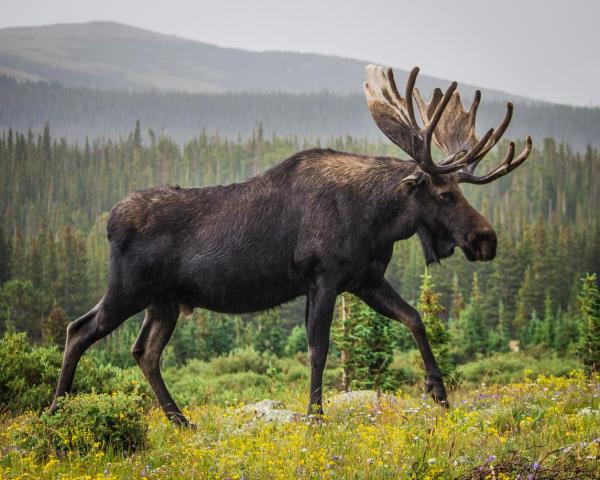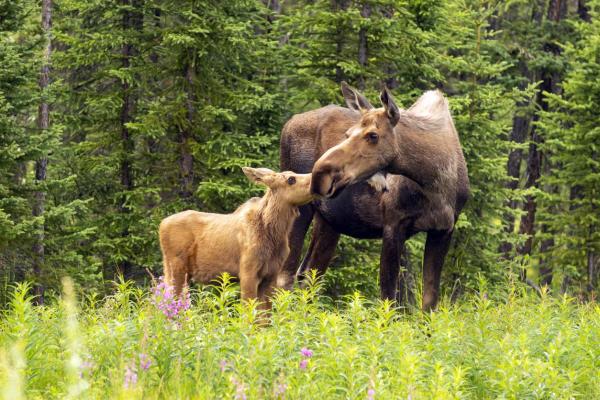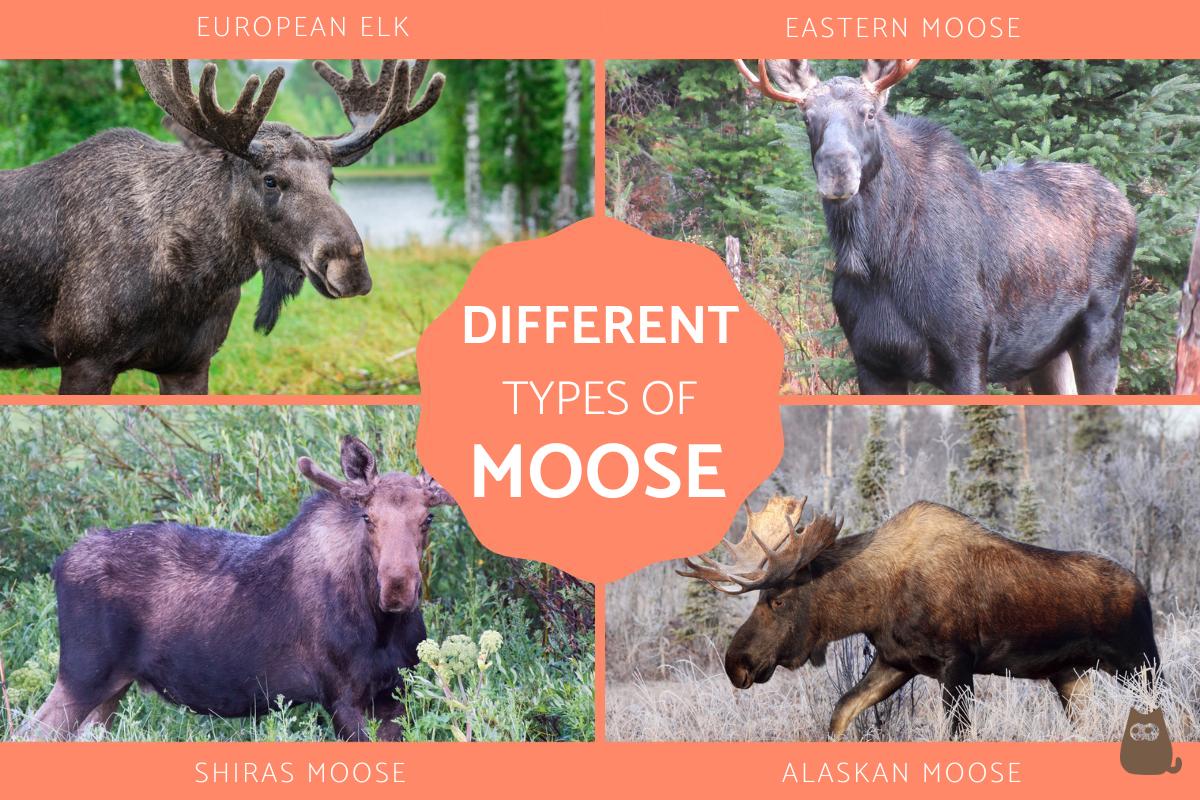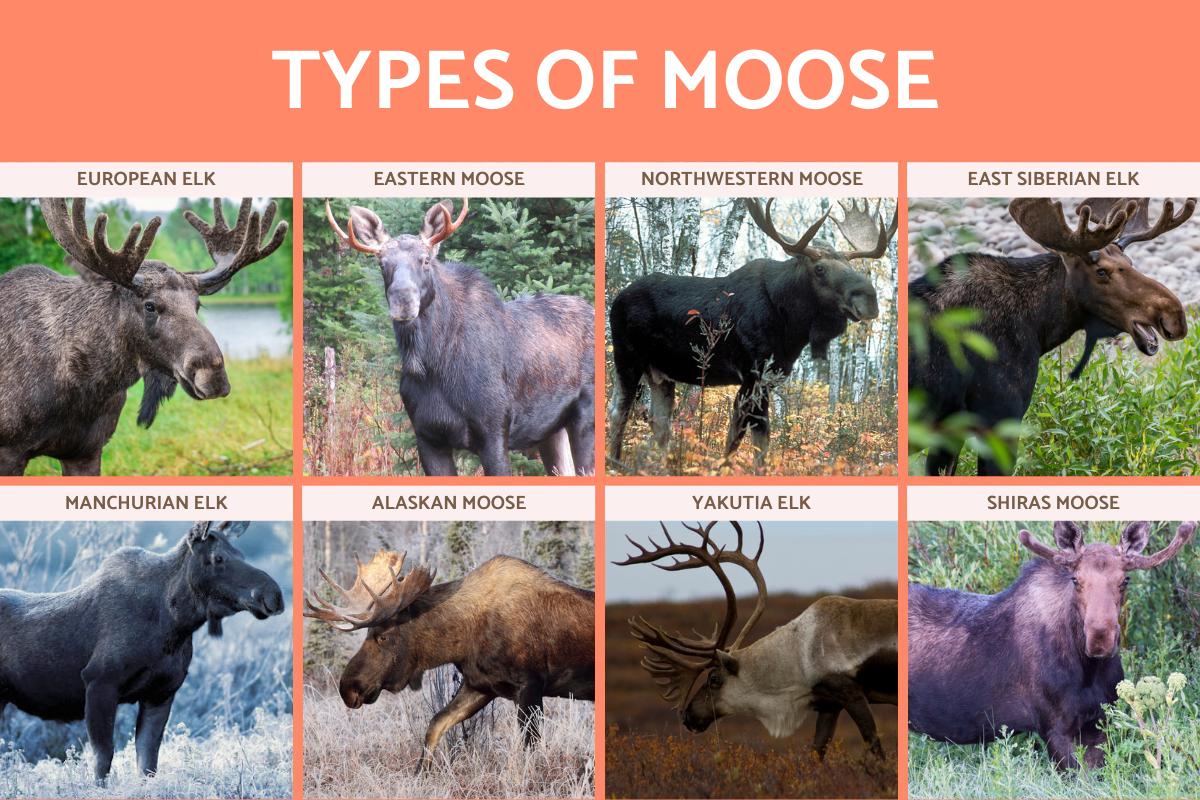Different Types of Moose


When we refer to the different types of moose, we are not referring to different species. All moose types are part of the species known taxonomically as Alces alces. A member of the deer family (Cervidae), they are the largest extant species of deer. They are known for their imposing heft, especially when they have their full antlers. With these large bone appendages, we can see the moose must have considerable strength just to lift their head. Although moose are only one species, there are various subspecies of moose which differ according to certain traits. With such a wide distribution, these differences are often a result of adaptations to their habitat.
At AnimalWised, we discover the different types of moose. We name all the subspecies of moose, as well as any other variations in the animal. We also provide photos so you can have a clearer idea of their similarities and differences.
Moose Classification
The scientific or taxonomic classification of moose has had some controversy over the years. This is largely due to the differences in morphology and geographical distribution. While genetic coding has allowed greater insight into the relationships between these types of deer species, geneticists continue to argue over whether they should be classified as different types of moose (Alces alces) or as a separate species of their own.
Currently, the different types of moose depicted in the photo above are generally considered to be subspecies of Alces alces. In terms of taxonomic rankings, the International Union for Conservation of Nature (IUCN)[1] classifies them as such:
- Kingdom: Animalia
- Phylum: Chordata
- Class: Mammalia
- Order: Cetartiodactyla
- Family: Cervidae
- Genus: Alces
- Species: Alces alces
- Subspecies: Alces alces alces; Alces alces Americana; Alces alces andersoni; Alces alces buturlini; Alces alces cameloids; Alces alces gigas; Alces alces pfizenmayeri; and Alces alces shirasi.
Alternative taxonomic rankings have been suggested. According to the editors of Mammal Species of the World[2], the moose has two species with further subspecies. They are:
- Kingdom: Animalia
- Phylum: Chordata
- Class: Mammalia
- Order: Artiodactyla
- Family: Cervidae
- Genus: Alces
- Species: Alces alces
- Subspecies: Moose alces alces and Moose alces caucasicus.
- Species: Alces americanus
- Subspecies: Alces americanus americanus and Alces americanus cameloides
The IUCN is the most widely recognized. However, scientific groupings are always in a state of flux, so this may differ in the future.
What are the characteristics of moose?
Before we look at the individual types of moose, we look at the different characteristics shared by all moose. They include the following:
- Moose are the largest members of the cervid group. Their weight ranges between 595 to 1698 lb (270 to 770 kg). As for dimensions, they range from 7.5 to 10 ft (2.3 to 3.1 m) in length.
- They have a characteristic solid body, which is supported by long, but thin legs.
- The neck is short, but very thick which helps them to hold up their antlers.
- The head is large, with a wide and prominent snout. This is peculiar among the different types of deer species.
- The eyes are small in relation to the head, the upper lip protrudes above the lower lip and there is an area devoid of fur on the nose.
- Below the neck in males is the bell, a flap of skin that is sometimes also present in females, but not always.
- Another characteristic of moose is that they exhibit sexual dimorphism. In this way, males are heavier than females and have flared antlers that can weigh up to 77 lb (35 kg). In some subspecies, these skull extensions have different shapes.
- Moose have thick fur that protects them from the cold. It is usually dark, brown, black or grayish in color, although it tends to lighten towards the extremities.
While these characteristics of moose are unique to the animal, they also share various characteristics with our deer species. Learn more about these similarities and differences with our article on the difference between deer, elk, moose and reindeer.

Different types of moose
The scientific debate regarding the types of moose that exist has not yet been resolved. As we have previously stated, two recognized sources on animals propose different animal groupings.
The debate largely centers on the interpretation of chromosomes. The proposal is that instead of one moose species (Alces alces), there are two separate species of moose (Alces alces and Alces americanus). Some scientists do not believe the genetic differences are sufficiently different to warrant the existence of two separate species. Some even do not believe they are sufficiently different to establish subspecies.
Morphological and genetic differences do exist, leading to the generally accepted ranking of subspecies in the species Alces alces. Following the IUCN classification, there are 8 extant types of moose (seen in the photos below):
- European elk (Alces alces alces): this moose type is distributed throughout Scandinavia, Finland, the Baltic states and Poland to the Yenisei River.
- Eastern moose (Alces alces americana): distributed throughout eastern Canada.
- Northwestern moose (Alces alces andersoni): populations of this moose subspecies are found throughout British Columbia, but range as far as Ontario and Minnesota.
- East Siberian elk (Alces alces buturlini): lives in the northeast of Siberia and Kamchatka.
- Manchurian elk (Alces alces cameloides): population ranges from northern Mongolia to Ussuriland and northern Manchuria.
- Alaskan moose (Alces alces gigas): lives in the Alaska region and the Yukon.
- Yakutia elk (Alces alces pfizenmayeri): subspecies is present in Siberia and the Stanovoy and Cherskiy mountains.
- Shiras moose (Alces alces shirasi): also known as the Yellowstone moose, it lives from southern Alberta to Wyoming and Utah.
As you may be able to see, the Eurasian moose subspecies are given the common name of elk. It is only in North America that these deer species are known as moose.

Where do moose live?
Moose are distributed in a significant diversity of habitats. They live in mainly forested areas, whether coniferous or deciduous. In this sense, they are present tundra as well as taiga ecosystems, including boreal and temperate zones. This is thanks to a strong tolerance to low ambient temperatures.
There is a preference in moose subspecies for secondary boreal forests with the presence of open spaces, swamps, wetlands and lakes. They are tolerant of secondary growth forests that previously had logging uses. As long as there are nearby forests, they can be present in lowland and cultivated lands.
Although the habitat of moose is very varied, it is a species that avoids summer temperatures. When the temperatures rise, they tend to take refuge in dense areas with the presence of bodies of water.
What do moose eat?
Moose are types of herbivorous mammals, consuming a large amount of vegetation per day. They feed mainly on the leaves and branches of various species, depending on availability during each season. Some of the plants they prefer in spring and summer are birch, ash and willow. In autumn and winter, generally they opt for fir, alpine and juniper. They can also include blueberries, heather, herbs and even aquatic plants in the moose diet.
In summer, moose in Alaska and Canada consume mineral sheets through which they meet sodium needs. These are created by the mineral accumulation which can arise from groundwater. Moose make migratory movements to look for food. In areas with some crops, they can cause serious agricultural damage by consuming them in massive quantities.
How do moose reproduce?
Two reproductive strategies have been identified in moose. Those that live towards the tundra tend to form groups where males and females attract each other through sounds and urine marking. Once grouped, a dominant male may compete with other individuals of similar size for reproductive privilege. During this time, the young moose move away. Moose distributed in ecosystems such as the taiga can form temporary pairs, so a male will seek to have exclusivity with a female until he mates with her.
These cervids reproduce between September and October of each year, with females having an estrous cycle of 24 to 25 days and a heat cycle of only 15-26 hours. The average gestation time is around 231 days. Although they usually have one calf (as depicted in photo below), the birth of twins occurs with some frequency.

Conservation Status of Moose
The IUCN has classified the moose in the category of least concern, with an increasing population trend. This does not mean that all the Alces alces subspecies are without threat. The main threat to moose is habitat modification, which is transformed primarily by forestry and agricultural practices. Certain deer diseases can also affect these animals.
There is a distinction in conservation status in Canada and Nova Scotia, places where the moose has been declared endangered. In these regions, the species is affected by illegal hunting, health problems, habitat fragmentation and changes that are possibly associated with the climate variations.
You can discover more about deer classification with our article looking at the differences between a doe and a fawn.
If you want to read similar articles to Different Types of Moose, we recommend you visit our Facts about the animal kingdom category.
- Hundertmark, K. (2016). Moose moose . The IUCN Red List of Threatened Species. https://dx.doi.org/10.2305/IUCN.UK.2016-1.RLTS.T56003281A22157381.en
- Don E. Wilson & DeeAnn M. Reeder (editors). (2005). Mammal Species of the World. A Taxonomic and Geographic Reference (3rd ed), Johns Hopkins University Press, 2,142 pp.http://www.departments.bucknell.edu/biology/resources/msw3/browse.asp?s=y&id=14200207
- De Bord, D. (2009). Moose moose. Animal Diversity Web. https://animaldiversity.org/accounts/Alces_alces/








